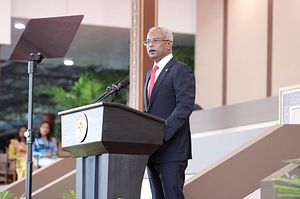With a new government under President Ibrahim Mohamed Solih in office, the Maldives appears ready to get its relationship with India back on track.
Prime Minister Narendra Modi made his maiden visit to the Maldives earlier in the month for the swearing in ceremony of Solih. A joint statement signed by the two leaders noted the “importance of maintaining peace and security in the Indian Ocean and being mindful of each other’s concerns and aspirations for the stability of the region,” a clear reference to recent controversies in their relationship.
Solih also used the opportunity to apprise Modi of the urgent assistance needed in the areas of housing and infrastructure as well as setting up water and sewerage systems in the remote islands.
Following tradition and highlighting India’s importance to the Maldives, the new president will be visiting India on December 17. Within a few days of Modi’s visit, a number of Maldivian ministers and officials visited India, including Foreign Minister Abdulla Shahid, Finance Minister Ibrahim Ameer, Economic Development Minister Fayyaz Ismail, Minister of State for Foreign Affairs Ahmed Khaleel, and Foreign Secretary Abdul Ghafoor Mohamed.
There are definitely some signs of a fresh beginning. The Ministry of External Affairs in a statement, following the foreign minister’s visit, said that “India attaches highest importance to its relationship with the Maldives which is marked by trust, transparency, mutual understanding and sensitivity.” Further, Minister of External Affairs Sushma Swaraj noted that as per India’s “Neighborhood First Policy,” India “stands ready to fully support the Government of Maldives in its socio-economic development.” The statement further noted that Maldivian Foreign Minister Abdulla Shahid had reiterated his government’s “India First” policy and had said that his government looks forward to working closely with the government of India on all issues.
The two ministers discussed defense and security cooperation and scheduled the next meeting of the Defense Cooperation Dialogue between India and the Maldives in the first half of December 2018. The foreign minister also noted that the Maldives has asked India for a Dornier aircraft and the MEA has also “promised that it would be delivered soon.”
These developments are significant because the Maldives under the previous Abdullah Yameen regime seemed to be slipping into China’s orbit. For instance, the Maldives had signed a new law permitting developers to own islands on lease for development for a period of 99 years. Subsequently, a Chinese company took control of Feydhoo Finolhu, an uninhabited island close to Male and its international airport, on a development lease for 50 years for $4 million.
The current finance minister is also now finding out that China is running “most of these projects (are) at inflated price” but many of them are now completed, which means these are fait accompli. But the new government is reviewing every project that is yet to be completed. For instance, a Male hospital project given to China has already cost $140 million, whereas a rival cost estimate was just $54 million.
The two countries also signed free trade agreement (FTA), which took India by total surprise and one that could have longer term implications for India. In addition to the strategic concerns, India has worries that Chinese goods dumped in Maldives could find its way into India.
The negative impact of the China FTA for the Maldives is huge too. Mohamed Nasheed, former Maldivian President and now adviser to Solih, recently said the trade imbalance is quite enormous and called the FTA “very one-sided” arrangement. Chinese companies also benefited disproportionately, pouring in large sums of money into infrastructure projects, including upgrading of the airport at a cost of $830 million and building a bridge linking the airport to Male at a cost of $400 million. Beijing now worries that Male will scrap some of the agreements.
Even as the economic component of the relationship is significant to Beijing, it is the geographical location of the Maldives in the Indian Ocean that appears to have been of the greatest interest. With the Maldives endorsing China’s Belt and Road Initiative (BRI) and signing a Memorandum of Understanding (MoU) on the Maritime Silk Road, Beijing felt that it had developed better hold and influence over a crucial piece of real estate in the Indian Ocean.
The fact that India enjoyed unparalleled access and influence in many of the Indian Ocean island states, including the Maldives, Seychelles, and Mauritius has been a problem for China. India has been the unofficial security guarantor to these states, providing patrol vessels, helicopters, and military training. So China’s interest in the Maldives was understandable and Beijing was able to secure its interests in Male through the “raw power of financial incentives” to the detriment of Indian interests.
With a new government in the island nation, there is much hope in India that New Delhi and Male will be able to undo some of the damage under the previous regime. Both Modi and Sushma Swaraj, as well as the Indian Defense Minister Nirmala Sitharaman, have promised significant help to deepen and expand the partnership while helping to prevent Maldives from falling into a possible debt trap with China.
However, like in India’s relations with other smaller neighbors, the key question is one of delivery. India has to be mindful of the fact it is competing with China in many of these projects and India will be judged against China’s accomplishments.
Even though things have turned around for India politically in many of the neighboring countries such as Sri Lanka and the Maldives, New Delhi’s ability to match China in providing economic and infrastructural assistance is open to question. While dealing with smaller neighbors, India also needs to become a lot more magnanimous, staying true to its own “Gujral doctrine,” thus creating greater confidence. India has a great opportunity in the Maldives to demonstrate that it can learn from its previous errors.

































